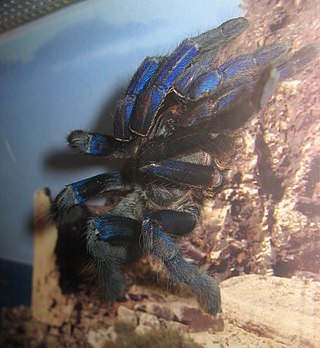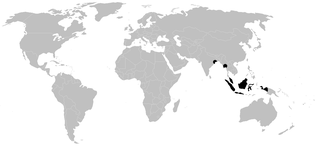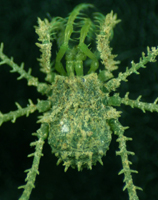Related Research Articles

Myrmarachne is a genus of ant-mimicking jumping spiders that was first described by W. S. MacLeay in 1839. They are commonly called ant-mimicking spiders, but they are not the only spiders that have this attribute. The name is a combination of Ancient Greek μύρμηξ, meaning "ant", and ἀράχνη, meaning "spider".

Cleistanthus is a plant genus of the family Phyllanthaceae, tribe Bridelieae, first described as a genus in 1848. It is widespread in much of the Old World Tropics in Asia, Africa, Australia, and various oceanic islands. Cleistanthus collinus is known for being toxic and may be the agent of homicides or suicides.

Drypetes is a plant genus of the family Putranjivaceae, in the order Malpighiales.

Ornithoctoninae is a subfamily of tarantulas found in Southeast Asia. It was first erected in 1895 by Reginald Innes Pocock based on the type specimen Ornithoctonus andersoni.

Heteropoda is a genus of spiders in the family Sparassidae, the huntsman spiders. They are mainly distributed in tropical Asia and Australia, while at least one species, H. venatoria, has a cosmopolitan distribution, and H. variegata occurs in the Mediterranean.
Pacullidae is a family of araneomorph spiders first described by Eugène Simon in 1894. It was merged into Tetrablemmidae in 1958, then raised back to family status after a large phylogenetic study in 2017.

The Sclerosomatidae are a family of harvestmen with about 1,300 known species. One former subfamily has been recently removed to form a new family, Globipedidae.

The Stylocellidae are a family of harvestmen with about 30 described species, all of which occur from India to New Guinea. Members of this family are from one to seven millimeters long. While Stylocellus species have eyes, these are absent in the other two genera.

Epedanidae is a family of the harvestman infraorder Grassatores with about 200 described species. They are the sister group of the Gonyleptoidea.

Podoctidae is a family of the harvestman infraorder Grassatores with about 130 described species.

Schismatoglottis is a genus of flowering plants in the family Araceae. Members of the genus are similar in appearance and growth habit to those of the genus Homalomena, but the two genera are not closely related. The primary difference is that the leaves of Schismatoglottis are not aromatic. Schismatoglottis are found primarily in tropical parts of Southeast Asia, New Guinea, and Melanesia. The majority of the species are native to the Island of Borneo.

Thelyphonus is the type genus of whip scorpions or 'vinegaroons' in the subfamily Thelyphoninae, with species found in Southeast Asia.
References
- 1 2 3 Özdikmen, Hüseyin; Kury, Adriano Brilhante (2007). "Replacement Names for Oncopus and Oncopodidae (Arachnida, Opiliones)". Journal of Arachnology. 35 (2): 407–408. doi:10.1636/h05-46.1. S2CID 86046606.
- 1 2 3 Schwendinger, Peter (2007): Oncopodidae. Kury & Pérez G., 2002. In: Pinto-da-Rocha et al. 2007: 211ff
- Joel Hallan's Biology Catalog: Oncopodidae